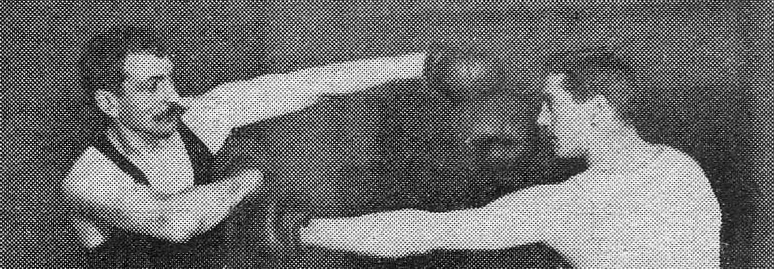- Originally published on the Bartitsu.org site on Tuesday, 27th March 2018

This article assumes that the object is to train in a neo-Bartitsu that is as close as possible to the original style. Therefore, the approach described here is very closely based on the primary, canonical sources, especially E.W. Barton-Wright’s own comments on this subject from late 1901 and early 1902, at which point his “Bartitsu experiment” was fairly well-established. By that time, most of the Bartitsu Club instructors had been working together on an almost daily basis for at least a year, and in some cases for nearly three years.
The evidence overwhelmingly indicates that unarmed Bartitsu was a new, hybrid method drawing primarily from boxing, kicking and an eclectic blend of jiujitsu styles. At a time when Barton-Wright’s club was literally the only place outside of Japan where students could formally study Japanese unarmed combat, jiujitsu was, reasonably enough, considered to be something of a “secret” art. In fact, it was frequently referred to as such by Barton-Wright and others during this period.
The formal, kata-based pedagogy of ko-ryu jiujitsu was, however, typically predicated on defences against single, highly committed attacks. During late 1901, Barton-Wright pointed out that this pedagogy was not necessarily equipped to counter attacks such as the quick, aggressive combinations of a skilled boxer or savateur, nor (perhaps) the unpredictable flurries of strikes that might be made by an untrained street brawler.
As Barton-Wright commented:
In order to ensure, as far as it is possible, immunity against injury in cowardly attacks or quarrels, one must understand boxing in order to thoroughly appreciate the danger and rapidity of a well-directed blow, and the particular parts of the body which are scientifically attacked. The same, of course, applies to the use of the foot or the stick.
He continued:
Ju-do and Ju-jitsu were not designed as primary means of attack and defence against a boxer or a man who kicks you, but are only supposed to be used after coming to close quarters, and in order to get to close quarters it is absolutely necessary to understand boxing and the use of the foot.
The experience of numerous subsequent martial arts and combat sports, notably including modern MMA, has tended to confirm Barton-Wright’s observation in this regard. Without putting too fine a point on it, the defences of boxing and savate are optimised for attacks made in those styles.
As Barton-Wright noted in the 1901 article Bartitsu: Its Exponent Interviewed, however, orthodox boxing/savate defences – as typically taught to middle-class students in commercial schools, geared entirely towards relatively safe competition – could be modified and improved towards the goal of winning a street fight:
The amateur (boxer) is seldom taught how to hit really hard, which is what you must do in a row. Nor is he protected against the savate, which would certainly be used on him by foreign ruffians, or the cowardly kicks often given by the English Hooligan. A little knowledge of boxing is really rather a disadvantage to (the defender) if his assailant happens to be skilled at it, because (the assailant) will will know exactly how his victim is likely to hit and guard.
He then clarified:
Another branch of Bartitsu is that in which the feet and hands are both employed, and which is an adaptation of boxing and Savate. The guards are done in a slightly different style from boxing, being much more numerous as well. The use of the feet is also done quite differently from the French Savate.
As to boxing, we have guards which are not at all like the guards taught in schools, and which will make the assailant hurt his own hand and arm very seriously. So we teach a savate not at all like the French savate, but much more deadly, and which, if properly used, will smash the opponent’s ankle or even his ribs. Even if it be not used, it is very useful in teaching the pupil to keep his feet, which are almost as important in a scrimmage as his head.

Thus, Bartitsu guards represented an aggressive, damaging modification to the standard blocks of boxing and savate. The opponent’s strikes would be met percussively, the defender chopping into punches with elbow/forearm strikes or offering the sharp wedge of an elbow-forward shield, as well as counter-kicking into attacking shins and ankles, as a precursor to finishing the fight at closer quarters.
By his own account, Barton-Wright clearly considered Japanese unarmed combat to be superior to other forms of wrestling as a means of self-defence. This consideration implicitly included the various European folk-styles available at the turn of the 20th century. Thus, whereas an unarmed Bartitsu exponent might square off against an assailant in an orthodox circa 1900 boxing/savate guard stance, and would certainly attempt to damage their attacking limbs with percussive guards, (s)he would be well-prepared to finish the fight with jiujitsu:
If one gets into a row and plays the game in the recognised style of English fair play – with fists – the opponent will very likely rush in and close, in order to avoid a blow. Then comes the moment for wrestling in the secret Japanese way. Instantly the unwary one is caught and thrown so violently that he is placed hors de combat, without even sufficient strength left to retire unassisted from the field.
The overall strategy Barton-Wright advocated for unarmed Bartitsu is, therefore:
- To assume a boxing/savate guard stance if possible, encouraging the opponent to attempt to punch or kick in the “orthodox styles”
- If the opponent does attempt to punch or kick, counter in the first instance by striking into the attacking limbs
Alternatively:
- If the opponent attempts to break through the defender’s guard with a grappling attack, allow it
And then, in either case –
- Finish the fight with jiujitsu throws and/or jointlocks.
